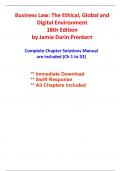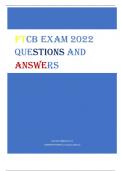Business Law: The Ethical, Global and
Digital Environment
18th Edition
by Jamie Darin Prenkert
Complete Chapter Solutions Manual
are included (Ch 1 to 52)
** Immediate Download
** Swift Response
** All Chapters included
,Chapter 01 - The Nature of Law
CHAPTER 01
THE NATURE OF LAW
I. OBJECTIVES:
As its title suggests, this chapter seeks to acquaint students with the general nature of law. The
chapter does this by: (1) describing the different types of law; (2) examining legal philosophy or
jurisprudence; (3) sketching some of law's functions; and (4) discussing legal reasoning. The
chapter’s content maximizes instructor discretion by keeping these four subjects as distinct from
each other as possible. As a result, you may feel you do not need to teach or assign certain parts
of the chapter. The material on the types of law, however, is basic material that any instructor
probably would want to present or assign.
II. ANSWERS TO INTRODUCTORY PROBLEM:
A. See the major types of law discussed in Chapter 1 (especially constitutions, statutes, common
law, administrative regulations and decisions, and treaties).
B. See the schools of jurisprudence discussed in Chapter 1.
C. See the "Legal Reasoning" section of Chapter 1 for discussion of the role courts play in
making and interpreting law. That section also discusses two important methods of legal
reasoning: case law reasoning and statutory interpretation.
D. The question about the relationship between legal standards of behavior and notions of ethical
conduct is largely rhetorical at this point. It will be explored more fully at later points.
III. SUGGESTIONS FOR LECTURE PREPARATION:
A. Types of Law
1. The material in this section can be viewed as one response to the question: "What is
law?" The section answers this question by listing and describing the kinds of rules that
commonly are regarded as law in the United States. What unites most of them is their
issuance by a legitimate political authority. Remind students that he first question in the
chapter’s opening vignette concerns types of law.
2. We do not use the term "sources of law" to identify this material because in ordinary
language the things described are law rather than sources of law. A statute, for instance,
is colloquially referred to as a law, and the legislature is ordinarily regarded as its source.
3. Provide students an overview (including examples) of each of the types of law outlined in
the text. Keep in mind the following:
a. The text's description of the functions served by constitutions and of separation of
powers and federalism is traditional and somewhat limited. You might want to add
that, as Chapter 3 suggests, the political and legal reality often differs from the
accepted homilies in these areas.
1-1
, Chapter 01 - The Nature of Law
b. Note the role played by courts—most notably the Supreme Court—in interpreting the
U.S. Constitution. Comment on Presidents’ attempts to shape the judiciary through
appointments (subject to Senate confirmation) to the federal district courts, courts of
appeal, and the Supreme Court. Mention confirmation fights that have occurred
through the years (e.g., regarding Bork and Thomas; perhaps Alito, Sotomayor, and
Kagan in more recent years, though the fights in those instances were less intense).
More recent examples here include the Republican-controlled Senate’s refusal to
consider President Obama’s nomination of Merrick Garland in 2016 and the resort to
the so-called “nuclear option” to stymie any attempt to filibuster President Trump’s
nomination of Neil Gorsuch in 2017. And, of course, the confirmation processes
were fraught for both Brent Kavanaugh and Amy Coney Barrett, though for quite
different reasons. Provide examples of Supreme Court justices who proved to be
consistent with the probable expectations of the Presidents who appointed them and
of justices who most likely were disappointments to the appointing President.
Burger, Rehnquist, Scalia, Thomas, Ginsburg, Alito, Sotomayor, Gorsuch would be
examples of the former. Warren, Brennan, Blackmun, Stevens, and Souter would be
examples of the latter.
c. The material on uniform acts is included here because students will so often
encounter uniform acts throughout the text. Of course, you should emphasize that
uniform acts are not law until enacted in whole or in part by a legislature, and that
state-by-state variations from the original text are common.
d. Emphasize that common law applies only when there is no other applicable type of
law and that statutes have a controlling effect with regard to the common law.
Therefore, Congress or a state legislature may enact a statute that abolishes or
modifies a common law rule. Advance Dental Care, Inc. v. SunTrust Bank, which
appears somewhat later in the chapter, illustrates this point. (See the later discussion
of this case.) A portion of the Cyberlaw in Action box does as well. In addition, see
Problem #1. Note, also, that a legislature may choose to enact a statute that codifies
what formerly was only a common law rule.
e. Price v. High Pointe Oil Company, Inc.: High Pointe Oil Company erroneously
filled Beckie Price’s basement with 400 gallons of oil, which destroyed her house
and all of her personal belongings. The oil came in through an “oil fill pipe” that
used to lead to an oil furnace in Price’s basement. A year prior, however, Price had
replaced the oil furnace with a propane model and had cancelled her contract with
High Pointe to keep oil in the furnace. High Pointe somehow included her address on
a “keep full” list, leading to the contamination. Although Price’s land was
remediated, her house rebuilt, and her belongings cleaned or replaced, she sued High
Pointe for negligence seeking noneconomic damages. After a jury awarded her
$100,000 and the appellate court affirmed, the Michigan Supreme Court had to
decide whether to adopt a new common law rule to allow the recovery of
noneconomic damages for the negligent destruction of real property. It declined to
do so.
Points for Discussion: Have a student summarize the basic facts and the
procedural history of the case. Because this is the first excerpted judicial opinion in
the text, it is also worthwhile to talk about why it is important to read the cases in the
text, how they help us understand and illustrate the legal rules discussed in the text
better. Point them to the Appendix at the end of the chapter for guidance on how to
read and brief a case. Moreover, as any case would, this case involves legal terms
and concepts with which students will likely be unfamiliar (e.g., plaintiff and
defendant, personal and real property, motions, tort and negligence). This can provide
instructors the opportunity to encourage students to make liberal use of a legal
1-2






